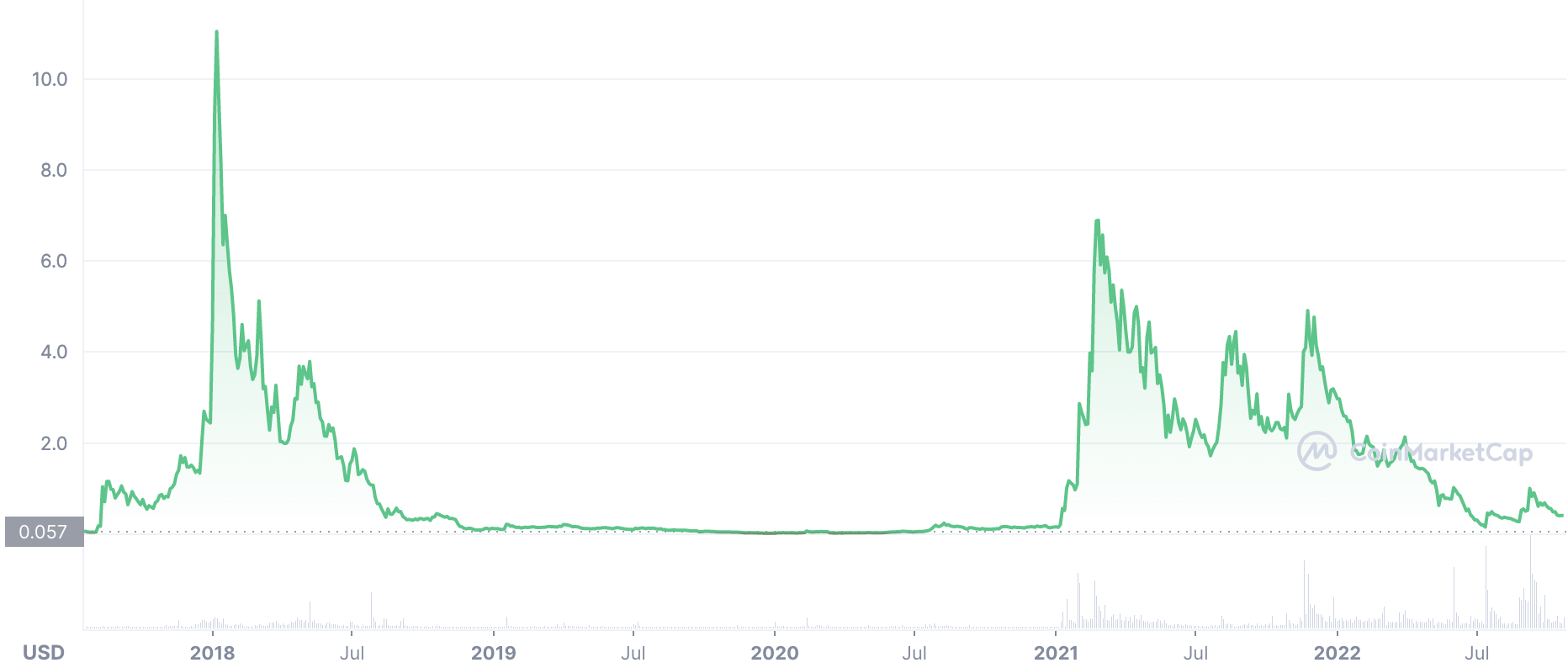Voyager crypto bankruptcy: How many VGX tokens will locked account holders get?
Binance and INX were completing for Voyager's assets after FTX collapse
The collapse of crypto exchange FTX in November 2022 threw a spanner in the works of Voyager Digital’s restructuring process.
FTX originally won the bid to acquire all of Voyager’s cryptocurrency assets in a deal worth $1.42bn in late September 2022. It was later reported that account holders at Voyager had a chance of recovering 72% of their assets on the completion of the FTX deal.
However, with FTX filing for bankruptcy in late November 2022, Voyager’s recovery plan was left in disarray.
Can Voyager’s customers expect to see their crypto assets? In this article we take a look at the Voyager crypto problems and relevant VGX coin news.
We will also talk about the recent pump in VGX prices and explore what could lie ahead for VGX coin holders and Voyager customers.
Voyager crypto bankruptcy: Will account holders receive their funds?
According to Voyager’s 6 July press release, account holders with cryptocurrencies in their Voyager accounts will receive a combination of cryptos, proceeds from the 3AC recovery, common shares in a newly reorganised company and VGX tokens.
How many VGX tokens will locked account holders get? According to Voyager, its plan “contemplates an opportunity” to allow customers to elect the proportion of common equity and crypto they receive, subject to maximum thresholds.
However, the compensation plan requires court approval and could change based on the ongoing discussions between parties, the company added.
Customers with US dollar deposits in their accounts will receive access to funds after a reconciliation and fraud prevention process is completed with Metropolitan Commercial Bank.
Robert Honeywell, restructuring partner at multinational law firm K&L Gates, speaking about Voyager to Axios, said:
Voyager said on 6 July 2022 that it had over $110m in cash and crypto in hand, which would be used to support day-to-day operations during the bankruptcy process. The company held about $1.3bn in crypto assets on its platforms and claims of over $650m against 3AC.
Bankruptcy filings showed that several other companies, including Alameda Research, Wintermute Trading and Genesis Global Capital, owed a total of $1.12bn to Voyager, which included 3AC’s obligations.
Retrieving funds from 3AC may turn into an arduous task for Voyager, after the Singapore-based crypto hedge fund filed a Chapter 15 bankruptcy petition on 1 July. Chapter 15 cases seek complete investigation processes and protection from asset seizures.
Economist and former Forbes contributor Frances Coppola wrote in a blog post:
A late August press release from Voyager said account holders will receive an email from Voyager Digital Restructuring which will allow customers to view "how Voyager lists their account holdings."
Voyager said customers could submit their proof of claim by 3 October 2022 if they disagreed with their account holding information, or if claims were marked as “contingent”, “unliquidated” or “disputed”.
Voyager’s takeover auction
On 27 September 2022, FTX US won an auction to acquire all of Voyager’s cryptocurrency – worth $1.31bn according to market prices at the time of the auction. The deal value was disclosed to be $1.42bn.
On 21 October 2022, Voyager said the deal received court approval and urged all customers and creditors to vote in favour of the deal to complete its finalisation.
“Because we believe the Plan, including the sale to FTX US, maximises recoveries to Voyager’s creditors, we urge all customers and creditors to vote in favor of the Plan,” said Voyager.
However, as FTX collapsed in November 2022, Voyager had to start the process all over again.
Crypto trading platform INX submitted a non-binding letter of intent to buy Voyager’s crypto assets for an undisclosed fee on 30 November 2022. INX will be competing against Binance for Voyager.
Binance co-founder Changpeng Zhao stated his intent in an interview with Bloomberg on 24 November 2022. He said :
VGX pump scheme: Token surges after Voyager crypto bankruptcy
VGX token has seen extreme moves since Voyager’s bankruptcy. Market participants ignored the news of Voyager’s bankruptcy and instead chose to pump the VGX token by 121% on 12 July 2022.
On Twitter, several users posted tweets with the hashtag #PumpVGXJuly18. A Twitter handle named MetaFormLabs, which claimed to be a crypto venture firm, said in a now-deleted Tweet that there had been a plan to pump VGX to a target price $5 on 18 July.
Similar pump schemes were seen in the other fallen tokens, such as CEL. As of 14 July 2022, CEL token, which is issued by the bankrupt crypto lender Celsius Network, had returned about 90% over the previous 30 days despite the collapse of its parent company.
On 14 June 2022, a day after Celsius suspended customer withdrawals, the CEL token surged as much as over 800% to an intraday high of $2.57. Similar moves were seen on 20 June and 9 July as the CEL token closed the sessions 74% and 22% higher respectively.
The US State of Vermont’s Department of Financial Regulation noted in a statement that several online forums were encouraging investors to participate in a “short squeeze” of the CEL token.
“Investors who purchase CEL tokens are taking a risk that those tokens will sharply decrease in value, or even become worthless, in the future. Concerted efforts to manipulate the price of CEL may also violate state and federal laws,” said the DFR in a statement dated 12 July 2022.
After VGX’s over 100% surge on 12 July, the token rose as much as over 200% on 13 July, from an open price of $0.33 to an intraday high of $1.03.
It should be noted that crypto pump schemes are not uncommon in cryptocurrency markets and have been used by both scammers and whales as an exit strategy.
While Voyager Token has fallen from its high in July, it rallied following the news of FTX’s successful bid, climbing to a high of $1.17 on 8 September.
The VGX token was unable to sustain the rally. As of 5 Decemeber, VGX was down 85.5% in year-to-date terms and was trading at $0.438.
Voyager Digital: Rise and fall of TSX-listed crypto lender
Voyager Digital was founded in 2018 as a platform for trading and investing in cryptocurrencies. The company also offered interest to customers for depositing their crypto assets on the platform.
Voyager funded deposit yields as high as 12% annual percentage yield (APY) by lending cryptocurrencies to other companies. The crypto-native company also has its own cryptocurrency called the voyager token (VGX).
In September 2021, Voyager listed on the Toronto Stock Exchange. At that time the company was managing assets worth over $5bn and boasted more than two million users on its platform.
What is voyager token? VGX coins are primarily used as reward and loyalty tokens on the Voyager platform. VGX token holders were offered cashback rewards, commission-free trading and interest. As a part of its loyalty programme, the company launched Voyager crypto back rewards, where users were paid in VGX for every trade they executed on the Voyager app.
According to CoinMarketCap, the voyager token price was around $0.06 during its early days in July 2017. It hit an all-time high of $12.54 in January 2018. However, after Voyager’s crypto problems grew out of control in 2022, VGX slumped.
As of 5 October 2022, the coin was trading 96.5% below its record high at around $0.43.
Voyager Token (VGX) price chart

Source: CoinMarketCap
Voyager bankruptcy news: Road to collapse
In June 2022, a number of crypto firms such as Celsius (CEL) suspended cryptocurrency withdrawals for their customers after facing financial difficulties following the implosion of Terra, the collapse of 3AC and a crash in crypto prices.
Voyager had reassured account holders in a 14 June press release, saying:
Voyager CEO Steve Ehrlich had added that the company was “well capitalised and in a good position to weather this market cycle and protect customer assets”.
A few days later, Voyager Digital received $200m and 15,000 bitcoin (BTC) in a credit line from FTX-owned Alameda Research “to safeguard customer assets”.
The Voyager bankruptcy risk surfaced on 22 June, when the company revealed it had lent 15,250 BTC and $350m worth of USD coin (USDC) to collapsed hedge fund 3AC.
On 27 June, Voyager issued a notice of default to 3AC on its failure to repay the loans. By 2 July, Voyager announced that it would be “temporarily suspending” trading, deposits, withdrawals and loyalty rewards and said that it was pursuing all remedies to recover funds from 3AC.
On 6 July, Voyager filed for a voluntary Chapter 11 process in the US Bankruptcy Court of the Southern District of New York.
Two days later, the company said it sent a notice to the TSX for delisting its common shares.
“The prolonged volatility and contagion in the crypto markets over the past few months, and the default of Three Arrows Capital on a loan from the Company’s subsidiary, Voyager Digital, LLC, require us to take deliberate and decisive action now. The Chapter 11 process provides an efficient and equitable mechanism to maximise recovery,” said Voyager on 6 July 2022.
FAQs
What does Voyager’s bankruptcy mean?
Voyager’s ability to function as a company has been put into question after a collapse in crypto prices and the default of over $650m by Three Arrows Capital.
According to the US Securties Exchange Commission (SEC), filing for protection under the federal bankruptcy laws can help companies make plans to repay their debts. A bankrupt company might use Chapter 11 of the Bankruptcy Code to reorganise its business and try to become profitable again.
How many users does Voyager have?
According to its March quarter earnings report, total verified users on Voyager stood at 3.5 million.
Will I get my crypto back from Voyager?
Voyager has filed a Chapter 11 bankruptcy petition. According to the company, account holders with cryptocurrencies in their Voyager accounts will receive a combination of cryptos, proceeds from Three Arrows Capital recovery, common shares in a newly reorganised company and VGX tokens.